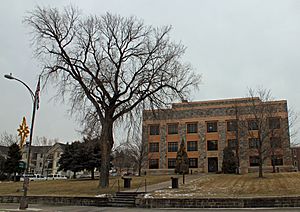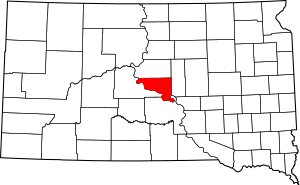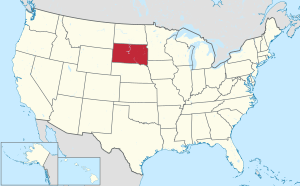Hughes County, South Dakota facts for kids
Quick facts for kids
Hughes County
|
|
|---|---|

Hughes County Courthouse in Pierre
|
|

Location within the U.S. state of South Dakota
|
|
 South Dakota's location within the U.S. |
|
| Country | |
| State | |
| Founded | January 8, 1873 (created) November 26, 1880 (organized) |
| Named for | Alexander Hughes |
| Seat | Pierre |
| Largest city | Pierre |
| Area | |
| • Total | 801 sq mi (2,070 km2) |
| • Land | 742 sq mi (1,920 km2) |
| • Water | 59 sq mi (150 km2) 7.4% |
| Population
(2020)
|
|
| • Total | 17,765 |
| • Estimate
(2023)
|
17,624 |
| • Density | 22.179/sq mi (8.563/km2) |
| Time zone | UTC−6 (Central) |
| • Summer (DST) | UTC−5 (CDT) |
| Congressional district | At-large |
Hughes County is a county in the U.S. state of South Dakota. As of the 2020 census, the population was 17,765, making it the least populous capital county in the nation, and the 12th most populous county in South Dakota. Its county seat is Pierre, which is also the state capital. The county was created in 1873, and was organized in 1880. It was named for Alexander Hughes, a legislator. On June 4, 1891, the county's area was increased by the addition of Farm Island, in the Missouri River downstream of Pierre.
Hughes County is part of the Pierre, SD Micropolitan Statistical Area.
Contents
Geography
The Missouri River forms the southwestern boundary line of Hughes County. The county's terrain consists of rolling hills cut by gullies and drainages. The area is partially dedicated to agriculture, including the use of center pivot irrigation.
The county terrain generally slopes to the southeast, although the hills along the west fall off into the river valley. The county's highest point is on the upper part of the east boundary line, at 1,952 ft (595 m) ASL. The county has a total area of 801 square miles (2,070 km2), of which 742 square miles (1,920 km2) is land and 59 square miles (150 km2) (7.4%) is water.
Major highways
Airport
Pierre Regional Airport (PIR) serves Hughes County and the surrounding communities.
Adjacent counties
- Sully County - north
- Hyde County - east
- Lyman County - south
- Stanley County - west
Protected areas
Source:
- Arikara State Game Production Area
- Buckeye State Game Production Area
- Cowan State Game Production Area
- DeGrey State Game Production Area
- DeGrey State Lakeside Use Area
- Dry Run State Game Production Area
- East Shore State Lakeside Use Area
- Farm Island State Recreation Area
- Fort George State Game Production Area
- Fort George State Lakeside Use Area
- Gutenkauf State Game Production Area
- Joe Creek Recreation Area
- LaFramboise Island State Nature Area
- North Bend State Lakeside Use Area
- North Big Bend State Game Production Area
- Oahe Mission Recreation Area
- Peoria Flats State Game Production Area
- Peoria Flats State Lakeside Use Area
- Rousseau State Game Production Area
- Rousseau State Lakeside Use Area
- Sand Creek State Game Production Area
- Spring Creek State Recreation Area
- Tailrace Recreation Area
- Valley state Game Production Area
- West Bend State Recreation Area
- West Big Bend State Game Production Area
- West DeGrey State Game Production Area
- Woodruff Lake State Game Production Area
Lakes
Source:
- Lake Oahe (part)
- Lake Sharpe (part)
- Woodruff Lake
Demographics
| Historical population | |||
|---|---|---|---|
| Census | Pop. | %± | |
| 1880 | 268 | — | |
| 1890 | 5,044 | 1,782.1% | |
| 1900 | 3,684 | −27.0% | |
| 1910 | 6,271 | 70.2% | |
| 1920 | 5,711 | −8.9% | |
| 1930 | 7,009 | 22.7% | |
| 1940 | 6,624 | −5.5% | |
| 1950 | 8,111 | 22.4% | |
| 1960 | 12,725 | 56.9% | |
| 1970 | 11,632 | −8.6% | |
| 1980 | 14,220 | 22.2% | |
| 1990 | 14,817 | 4.2% | |
| 2000 | 16,481 | 11.2% | |
| 2010 | 17,022 | 3.3% | |
| 2020 | 17,765 | 4.4% | |
| 2023 (est.) | 17,624 | 3.5% | |
| U.S. Decennial Census 1790-1960 1900-1990 1990-2000 2010-2020 |
|||
2020 census
As of the 2020 census, there were 17,765 people, 7,240 households, and 4,506 families residing in the county. The population density was 24.0 inhabitants per square mile (9.3/km2). There were 7,922 housing units.
2010 census
As of the 2010 census, there were 17,022 people, 7,066 households, and 4,435 families in the county. The population density was 23.0 inhabitants per square mile (8.9/km2). There were 7,623 housing units at an average density of 10.3 per square mile (4.0/km2). The racial makeup of the county was 85.7% white, 10.5% American Indian, 0.5% black or African American, 0.5% Asian, 0.5% from other races, and 2.3% from two or more races. Those of Hispanic or Latino origin made up 1.8% of the population. In terms of ancestry, 42.7% were German, 12.4% were Norwegian, 9.8% were Irish, 9.7% were English, and 3.8% were American.
Of the 7,066 households, 30.2% had children under the age of 18 living with them, 49.5% were married couples living together, 9.4% had a female householder with no husband present, 37.2% were non-families, and 32.3% of all households were made up of individuals. The average household size was 2.30 and the average family size was 2.90. The median age was 39.8 years.
The median income for a household in the county was $53,501 and the median income for a family was $70,881. Males had a median income of $42,701 versus $32,265 for females. The per capita income for the county was $28,236. About 7.1% of families and 9.3% of the population were below the poverty line, including 14.5% of those under age 18 and 6.0% of those age 65 or over.
Communities
Cities
Town
Census-designated place
- Oahe Acres
Unincorporated communities
Townships
- Raber
- Valley
Unorganized territories
- Crow Creek
- North Hughes
- West Hughes
Education
School districts include:
- Agar-Blunt-Onida School District 58-3
- Highmore-Harrold School District 34-2
- Pierre School District 32-2
See also
 In Spanish: Condado de Hughes (Dakota del Sur) para niños
In Spanish: Condado de Hughes (Dakota del Sur) para niños

